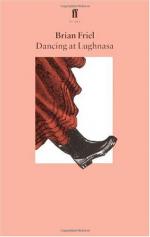|
This section contains 230 words (approx. 1 page at 400 words per page) |

|
Dancing at Lughnasa Summary & Study Guide Description
Dancing at Lughnasa Summary & Study Guide includes comprehensive information and analysis to help you understand the book. This study guide contains the following sections:
This detailed literature summary also contains Bibliography and a Free Quiz on Dancing at Lughnasa by Brian Friel.
Dancing at Lughnasa, by Brian Friel, one of Ireland's most important playwrights, was first performed at the Abby Theater, in Dublin, in 1990, and garnered the 1991 Olivier Award. In 1998, Dancing at Lughnasa was adapted to the screen in a film directed by Pat O'Connor and starring Meryl Streep.
Dancing at Lughnasa opens with a monologue by Michael, who introduces his nostalgic memories of the summer of 1936, when he was seven years old, and the five Mundy sisters, who raised him in rural Ireland, acquired their first wireless radio. Their older brother, Michael's Uncle Jack, had just returned from twenty-five years spent as a missionary in a leper colony in Uganda. Michael was born out of wedlock to Chris, the youngest of the Mundy sisters, and Gerry Evans, who deserted her and the child and only returns every couple of years to see her. The radio, which breaks down more than it works, unleashes unarticulated emotions in the five women, who spontaneously break into song and dance, with or without its aid. By the end of the year, as the older Michael explains in monologue, two of the sisters, Rose and Agnes, had run off, never to return, and Uncle Jack had died of a heart attack.
Friel's play employs the central motif of dancing and music to explore themes of Irish cultural identity, nostalgia, historical change, and pagan ritual.
Read more from the Study Guide
|
This section contains 230 words (approx. 1 page at 400 words per page) |

|



